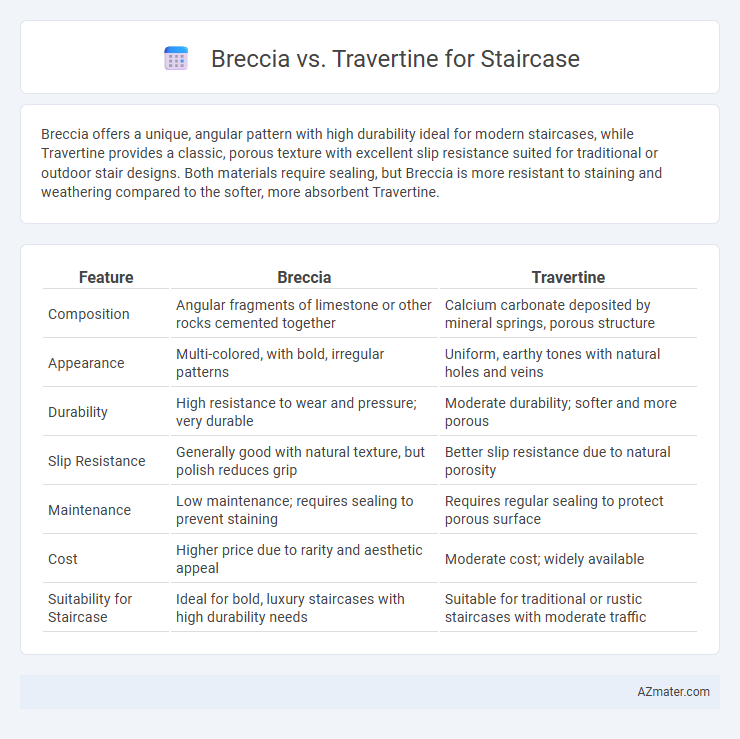Breccia offers a unique, angular pattern with high durability ideal for modern staircases, while Travertine provides a classic, porous texture with excellent slip resistance suited for traditional or outdoor stair designs. Both materials require sealing, but Breccia is more resistant to staining and weathering compared to the softer, more absorbent Travertine.
Table of Comparison
| Feature | Breccia | Travertine |
|---|---|---|
| Composition | Angular fragments of limestone or other rocks cemented together | Calcium carbonate deposited by mineral springs, porous structure |
| Appearance | Multi-colored, with bold, irregular patterns | Uniform, earthy tones with natural holes and veins |
| Durability | High resistance to wear and pressure; very durable | Moderate durability; softer and more porous |
| Slip Resistance | Generally good with natural texture, but polish reduces grip | Better slip resistance due to natural porosity |
| Maintenance | Low maintenance; requires sealing to prevent staining | Requires regular sealing to protect porous surface |
| Cost | Higher price due to rarity and aesthetic appeal | Moderate cost; widely available |
| Suitability for Staircase | Ideal for bold, luxury staircases with high durability needs | Suitable for traditional or rustic staircases with moderate traffic |
Understanding Breccia and Travertine: Key Differences
Breccia features angular fragments of varied stones cemented together, offering a bold, textured appearance ideal for staircases seeking a natural yet dramatic effect. Travertine, formed from mineral deposits in hot springs, provides a smoother, porous surface with a warm, earthy tone, making it suited for elegant, classic staircase designs. Key differences lie in Breccia's fragmented, multicolored pattern versus Travertine's consistent veining and softer color palette, impacting both aesthetic and maintenance considerations for staircases.
Aesthetic Appeal: Breccia vs Travertine for Stair Design
Breccia offers a bold, dramatic aesthetic with its fragmented, multicolored patterns that create a visually striking staircase focal point, making it ideal for statement stair designs. Travertine provides a more classic and elegant appeal with its smooth, porous texture and warm, earthy tones, lending a timeless and sophisticated ambiance to staircases. The choice between Breccia and Travertine for stair design ultimately hinges on whether a bold, artistic look or a refined, natural elegance is desired.
Durability Comparison: Which Stone Lasts Longer?
Breccia offers high durability due to its dense composition and resistance to wear, making it ideal for high-traffic staircases. Travertine, while aesthetically appealing with its porous texture, requires sealing to enhance its longevity but remains softer and more prone to chipping over time. When comparing durability, Breccia generally lasts longer than Travertine under heavy use and environmental exposure.
Maintenance Requirements for Breccia and Travertine Stairs
Breccia stairs require periodic sealing to prevent staining and maintain their vibrant, multicolored appearance, especially in high-traffic areas where dust and grit can cause abrasion. Travertine stairs demand more frequent sealing due to their porous surface, along with regular cleaning using pH-neutral products to avoid etching and surface damage. Both materials benefit from prompt spill cleanup, but Travertine's natural pits may necessitate filling or repair over time to ensure a smooth, safe staircase surface.
Slip Resistance and Safety Considerations
Breccia offers a rougher texture compared to the smoother surface of Travertine, enhancing slip resistance, which is crucial for staircase safety. Travertine's natural pores can become slippery when polished, requiring additional treatment like anti-slip coatings or textured finishes to improve traction. Selecting Breccia for staircases reduces slip hazards inherently, making it a safer option in high-traffic or wet environments.
Cost Analysis: Breccia vs Travertine Staircases
Breccia staircases typically have higher installation costs than travertine due to the stone's unique veining and irregular patterns, which require expert cutting and placement. Travertine is generally more affordable, with a price range of $20 to $50 per square foot, making it a cost-effective option for staircase surfaces. Maintenance expenses for breccia can also exceed those of travertine because breccia's porous nature demands frequent sealing to prevent staining and damage.
Installation Process: What to Expect
Breccia and travertine both require careful handling during staircase installation, with breccia demanding precise cutting due to its unique multi-colored, fragmented appearance to ensure seamless pattern alignment. Travertine involves filling natural voids with resin or cement before installation to create a smooth surface, which can extend preparation time. Both materials benefit from professional installation to address their specific porosity and density characteristics, ensuring durability and aesthetic quality on staircases.
Environmental Impact: Sustainability of Each Stone
Breccia and travertine differ significantly in their environmental impact due to their extraction and composition; breccia, a sedimentary rock composed of angular fragments, often requires more energy-intensive quarrying methods, potentially leading to greater habitat disruption. Travertine, formed from mineral deposits in thermal springs, is generally considered more sustainable because it can sometimes be sourced from recycled or reclaimed materials, minimizing environmental degradation. The sustainability of each stone also depends on transportation distances and quarrying practices, with travertine often favored for eco-friendly staircases due to its lower carbon footprint and ability to be reused.
Ideal Settings for Breccia and Travertine Stairs
Breccia stairs are ideal for settings that emphasize rustic, natural elegance, often enhancing outdoor patios, garden pathways, or Mediterranean-style homes where their unique veining and bold patterns stand out. Travertine stairs suit both interior and exterior applications in contemporary and classical designs, offering durability and a smooth texture perfect for high-traffic areas like entryways, pool surrounds, and luxury staircases. Both materials require sealing to prevent wear, but travertine's lighter color palette complements bright, airy spaces while breccia's rich tones add warmth and character to shaded or earthy environments.
Making the Right Choice for Your Staircase Project
Breccia offers a unique, dramatic appearance with its angular fragments and rich, contrasting colors, making it ideal for bold, statement staircases. Travertine provides a more classic, timeless look with its smooth texture and earthy tones, offering durability and slip resistance for high-traffic areas. Considering factors like maintenance, aesthetic preference, and the staircase location will help determine the optimal stone choice that balances beauty and functionality.

Infographic: Breccia vs Travertine for Staircase
 azmater.com
azmater.com